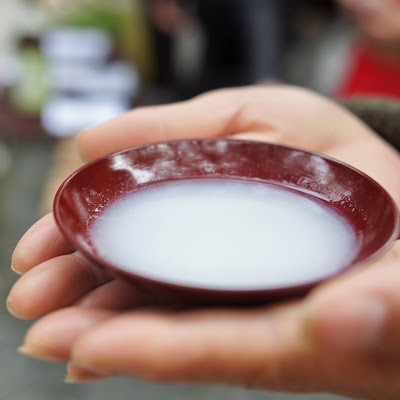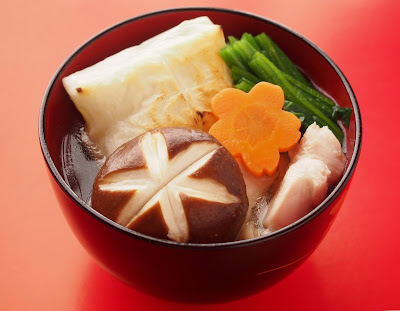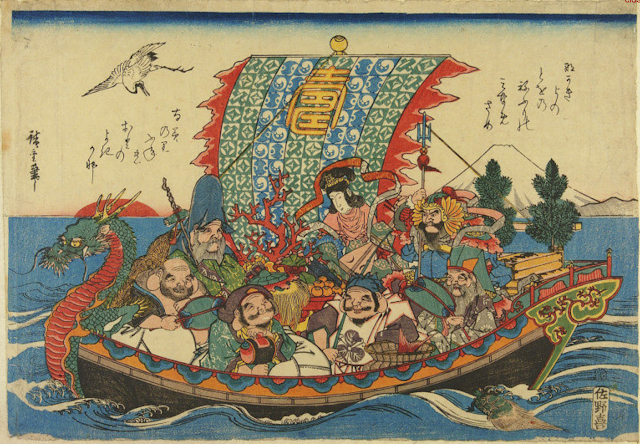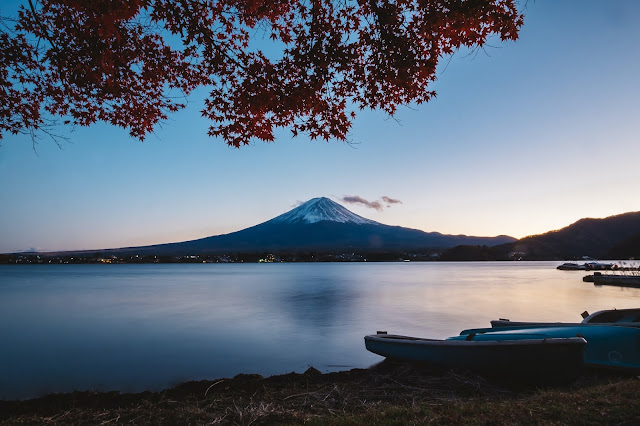Oshougatsu Part 2: Hatsu Mono–The Firsts of New Year's
新年の初物
Japanese treasure “hatsu mono” 初物–or first experiences: one’s first love, the first snow. When a new year begins, everything is a first! That means there is plenty to celebrate!
Many people make New Year’s resolutions, but few people keep them. In fact, they say that most people give up their New Year’s Resolutions by Valentine’s Day. If you are one of those people, don’t be discouraged. Every day is a new day. February is almost over, but whatever you committed to two months ago, just pick up where you left off.
Speaking of picking up where you left off–we are finally ready to share Oshougatsu Part 2. In this post we will be talking about first experiences and how to celebrate New Year’s the Japanese way. There are so many fascinating traditions–which ones will you incorporate into your festivities next year?
“Hatsumoude” 初詣 First Shrine Visit
For some people, the first event of the year occurs as the last stroke of the bell called “jouya no kane” 除夜の鐘 fades. From just after midnight until the middle of January, people go to nearby shrines and temples for their first visit of the year. They pray for safety and peace in the new year, as well as give thanks for the previous one. At some Shinto shrines the priests offer visitors a complementary drink.
“Omiki no Furumai” お神酒の振る舞い Sacred Sake Distribution
The three beverages typically served at shrines on New Year’s Day are omiki, “amazake” 甘酒, and "oshiruko" お汁粉. Omiki literally means “god sake,” and is believed to impart power on the drinker. Amazake is a warming drink with a distinct flavor, made from rice. Oshiruko is a sweet azuki bean soup, perfect for a chilly winter day
“Otoso,” お屠蘇 is another type of spiced sake, which people drink on "gantan" 元旦 (New Year's morning) to protect themselves against illness.
Your Turn! Learn how to make your own amazake or oshiruko, so you can serve it to your guests at the next New Year’s party.
“Omikuji” おみくじ Fortune Paper
Another hatsumoude custom is to draw one’s first fortune for the year. If the message written on the paper is good, you keep it. If it’s bad, you fold it up and tie it to a special omikuji rack in hopes that the fortune will change for the good.
“Hamaya” 破魔矢 Evil-Breaking Arrow
Some people insure their luck by purchasing a small wooden arrow from the shrine and displaying it in their homes. This charm is believed to ward off any potential calamities. It also represents taking your best shot for success. During the Edo Period, hamaya and “hamayumi” 破魔弓 were given as a set to celebrate a baby boy’s first New Year.
Your Turn! Not everyone believes in luck, but everyone hopes for success in life. If you can’t get your hands on hamaya, why not substitute it for a game of darts and take turns shooting for the bull’s eye?
“Hatsuhinode” 初日の出 First Sunrise
After hatsumoude, next on the schedule is hatsuhinode. Again, whatever you believe about luck, wouldn’t you say that watching the progressions of color that dye the sky as the sun comes up for the first time is a good way to start off the year?
Your Turn! How about scouting out a tall building, a stadium, or a hilltop to watch the “rising sun?” There couldn’t be anything more wa!
“Shinnen No Aisatsu” 新年の挨拶 New Year’s Greeting
The very first time you see somebody after "toshi ake" 年明け (the beginning of the new year), you are supposed to say the New Year’s greeting. It’s simple but absolutely indispensable.
First you say, “Akemashite omedetou gozaimasu!” 明けましておめでとうございます!
(The young and hip shorten it to, “Ake ome!” )
Next you say, “Kotoshi mo yoroshiku onegaishimasu!” 今年もよろしくお願いします!
(If you’re being very casual, you can say, “Kotoshi mo yoroshiku~!”)
Your Turn! If you have Japanese friends, relatives, or colleagues, it’s best to try to say the greeting on New Year’s Day. If you won’t see them on January 1, it’s the phrase acceptable to use anytime up until “Matsu No Uchi” 松の内, January 7 and possibly until January 15 ( Koshougatsu 小正月, or Little New Year’s).
“Ozoni” お雑煮 New Year’s Soup
Once hatsumoude and hatsuhinode are over, it’s time to go home and enjoy New Year’s ozoni.
Ozoni is the traditional miso and vegetable soup with mochi (rice cake). It is meant to be eaten on gantan. The exact ingredients and even the shape of the mochi vary greatly from household to household and region to region.
Your Turn! If you have a Japanese obaachan, her recipe is probably different from your Japanese friend’s obaachan’s recipe, which is probably different from the next obaachan’s recipe–in other words, it’s a precious heirloom! However, if you don’t happen to have to have the family cookbook, you can always visit Just One Cookbook for a basic recipe.
“Kotatsu” 炬燵 Kotatsu
In the past couple weeks, people in many parts of the world are experiencing unusually heavy snowfall. If that’s you, you probably wish you had a kotatsu, the low Japanese table draped with a blanket and equipped with a heater. You can actually purchase one on Amazon! But a word of warning: once you stick your legs into the warm blanket, you’ll be so comfortable you won’t be getting up again very soon, especially if there are snacks on the table. Of course, that makes it a perfect piece of furniture for New Year’s Day.
Your Turn! If you are not ready to invest in a kotatsu, you can substitute an electric blanket and warm slippers, and don’t forget to fill a basket with easy-to-peel “mikan” みかん mandarin oranges to snack on!
“Hanetsuki” 羽根突き
Hanetsuki is an antiquated game that resembles badminton. It is played with a small wooden paddle called hagoita. These days hagoita are more often displayed in homes as good luck charms or in businesses to wish for economic prosperity, and every year in Asakusa a giant hagoita market called “Tori no Ichi” is held. Vendors sell hagoita of all sizes, some simple and some extravagant. The faces of kabuki actors, geisha, and popular TV personalities adorn the colorful paddles.
Try it! Try adding a racket game to your New Year’s Day entertainment. Hanetsuki, tennis, badminton, ping pong, anything will do!
“Takoage” 凧揚げ Kite Flying
Takoage might sound like a special deep-fried octopus eaten on New Year’s day, but it’s actually a traditional source of entertainment that became all the rage in the Edo Period. Unfortunately, people were flying kites from their roofs and falling off, and it got banned. Out of the entire year, an exception was made for one day–January 1–which is why it became a traditional New Year’s activity.
Try it! If you have any nieces and nephews, they will probably be asking to go and play outside before New Year’s Day is done. How about teaching them how to make a kite and flying it together?
Plastic Kite Tutorial (English subtitles)
Kids’ Indoor Kite (Japanese)
“Karuta” カルタ
The name “karuta” comes from the Portuguese word “carta,” meaning card. There are endless versions of this card game according to different themes, but the classic one is called “Hyakunin Isshu” 百人一首 and is based on a collection of 100 classic Japanese poems. In the game, one player reads “kaminoku” or first three lines of the poem, and the other player grabs the card with “shimonoku” or the last two lines of the same poem. Japanese kids learn these poems in school and can be scarily fast.
Your Turn! Whack a Waka is a beautifully designed Hyakunin Isshu Karuta made for English speakers. You can order it on Amazon for about $30. You can learn a lot of Japanese culture this way!
“Kaki Zome” 書初め First Calligraphy of the Year
Kaki zome is also known as “hatsu suzuri” 初硯. “Suzuri” is the grinding of charcoal to make ink. The proper way to prepare it is to mix charcoal with “wakamizu” 若水, water drawn from the well on January 2. Famous poetry or excerpts from famous literary works are popular themes. Kakizome is one of the older New Year’s customs, beginning in the Heian Period (947-1185). If you are a minimalist and worried about accumulating piles of papers, don’t fret. On January 15, you can burn your artwork in a bonfire called “dondo yaki” どんど焼き. The higher the flames burn, the better your calligraphy skills will get!
Try It! If you want to try kakizome next year, you can order a reasonably priced shodo set or a simple brush pen on Amazon. Try writing a single kanji letter to represent your hopes for the year if a whole poem is too intimidating.
Tutorials:
“Fuku Bukuro,” 福袋 Lucky Bags
A new tradition of modern times, fuku bukuro are mystery bags full of discounted merchandise, and they seem to pop out of nowhere in every store in Tokyo around New Year’s.
Try it! “Fuku” means lucky, but “shukufuku” 祝福 means “blessing.” Why not put a twist on fuku bukuro by creating a shukufuku bukuro filled with handmade wafuu treasures (like origami or “e-tegami” 絵手紙 picture post cards) to bless someone with–whether it be your next door neighbor or someone living abroad?
Ayukane Origami on YouTube has tons of ideas for cute crafts.
横山寿美子 and 快適ART will teach you how to paint beautiful picture postcards.
”Hatsuyume” 初夢 First Dream
One final first takes place while you sleep on the night of January 1, the first dream of the year. What you dream about supposedly is an indicator of how lucky your year will be. You may already know the saying:
“Ichi fuji, ni taka, san nasu bi” 一富士二鷹三茄子
Number one Mt. Fuji, number two hawk, number three eggplant
Mt. Fuji is number one on the list for obvious reasons. The hawk is a wordplay on the word “takai,” 高い meaning “high,” and the mysterious eggplant is a wordplay on the word meaning “to accomplish.” Now try guessing the next three:
“Shi ougi, go tabako, roku zatou” 四扇五煙草六座頭
Number 4 folding fan, number five tobacco, number six blind, bald minstrel
Any guesses?
Answer: The fan when unfolded reminds people of increase and is associated with prosperity, the smoke from tobacco rising upwards symbolizes reaching great heights, and the bald minstrel is a clever wordplay on the phrases “ke ga nai,” 毛が無い meaning “have no hair,” and the homophonous phrase “kega nai,” 怪我無い meaning “have no injuries.”
If you’re want to increase the chances of dreaming about one of these six subjects, stick a picture of the Shichifukujin 七福神, or 7 gods of fortune, under your pillow.
Try It! Dreaming about a bald minstrel honestly sounds a little scary, so perhaps you would rather have a deep, sound sleep. If so, try making a DIY azuki weighted eye mask!
YouTube Tutorial (English)
That’s it! For those of you who grew up in Japan, which one of these traditions did you keep growing up? For those who did not, which customs stand out to you the most? And for all of our readers, which do you want to adopt?

















Again you researched so thoroughly! The only traditions I did on the list was the greeting, ozouni, kotatsu mikan, takoage, kakizome. What about otoshidama?
ReplyDeleteWonderful, Erika! These are all so good! I wish I could visit Tori No Ichi. I'd probably go crazy with all the hagoita, especially the kabuki ones. I want to become a person who makes hagoita and I follow several of them on Insta! I also concentrated very hard on hatsu-yume and had quite a colorful one (part of it already came true!) I love your adaptations of the traditions... very doable! By the bye, here's a cute video of Ebizo family playing karuta. https://www.youtube.com/watch?v=Y9JCICH-sPg
ReplyDelete